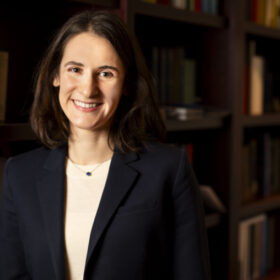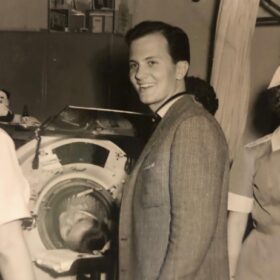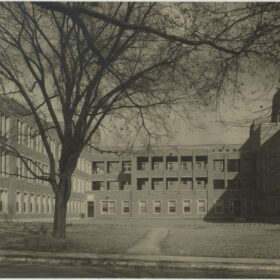Hidden Figure
In 1964, with little fanfare, Harold Jordan, MD, became the first African-American resident physician at Vanderbilt. Looking back to that time, he recalls the support of his colleagues and the challenges he faced.
September 5, 2017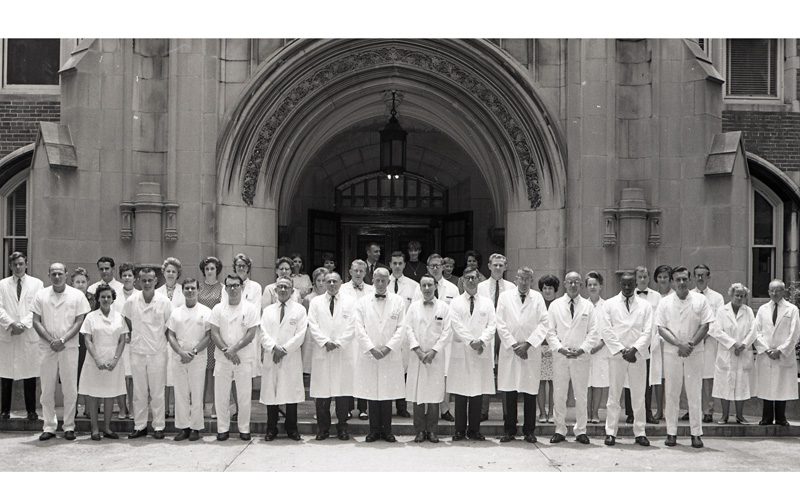
Vanderbilt Department of Psychiatry, 1967. Harold Jordan, MD, is the only African-American in a sea of white faces. (Photo from Eskind Biomedical Library Special Collections).
Editor’s note: The Fourth Annual Harold Jordan Lecture celebrating Diversity, Inclusion and Social Justice, presented by the Department of Psychiatry and Behavioral Sciences, is set for Friday, Feb. 25, 2022, at noon. The speaker is the University of Michigan’s Robert M. Sellers, PhD. For more information click here.
Harold Jordan, MD, has had a distinguished medical career that includes many highlights, including being chair of Psychiatry at Meharry Medical College, his medical alma mater, and serving as acting dean of the School of Medicine at Meharry as well.
Besides his academic career, Jordan was devoted to improving mental health care for the public through governmental service. He was Assistant Commissioner for Psychiatric Services and, following that, Commissioner of Mental Health and Mental Retardation for the state of Tennessee, and performed those jobs with such distinction that the state named a building in his honor on the campus of Clover Bottom Developmental Center, the state facility for people with severe intellectual disabilities which closed in 2016.
But a lesser-known part of Jordan’s professional life is his role as a pioneer at Vanderbilt University Medical Center (VUMC). In 1964 he became the first African-American resident physician at VUMC.
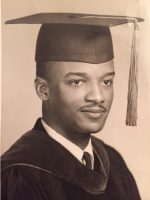
Jordan’s graduation photo from Meharry Medical College, taken shortly before he began his residency at Vanderbilt.
It’s fair to say that he began that groundbreaking achievement with little fanfare, and it’s fair to say that the achievement has received little fanfare since.
Reached at his home in California, where he moved after retirement, Jordan recalled interviewing with William F. Orr Jr., MD, who was chair of Psychiatry at Vanderbilt from 1947 to 1969.
“Dr. Lloyd Elam arranged for me to meet Dr. Orr,” he said. With bemused understatement, and the hint of a chuckle, he added, “Obviously, that was very good for me.”
Elam, who later served as President of Meharry, was on the Psychiatry faculty at that institution and recommended that Jordan, who had already done an internship year at Meharry in Internal Medicine, consider a slot at Vanderbilt because, at the time, Meharry did not offer a residency in Psychiatry.
The interview went well, and Orr offered Jordan one of the three residency slots in Psychiatry that year.
But, Jordan recalls, Orr did more than offer him a position.
“Dr. Orr was very encouraging, accepting and protective,” Jordan said, clearly recalling a time when not all institutions exhibited those attitudes toward African-Americans. “He made it clear that I would be accepted. I felt secure. I knew the path was clear for me.”
Jordan’s family roots in medicine are deep; both his great-grandfather and grandfather were physicians who trained at Meharry. When he was growing up in Newnan, Georgia, just south of Atlanta, he heard family tales of his medical forbears and was inspired to follow their footsteps.
“I had wanted to do that since I heard about them,” he said.
Despite the low-key nature with which Jordan’s residency was handled, the groundbreaking nature of what was going on would have been known to all of the participants.
Vanderbilt’s first African-American student, Joseph Johnson Jr., was admitted to the Divinity School in 1953, and in 1956 two Black law students had been admitted as well. But despite the presence of a few Black students on campus, at that time there were no African-American residents at Vanderbilt Hospital, and it would be two more years, 1966, before the Vanderbilt School of Medicine would admit its first African-American student, Levi Watkins Jr.
“He paved the way for everyone who came after him,” Churchwell said. “To be an African-American resident in a sea of white residents at a Southern medical institution, I would call him a true Robinson Crusoe.”
Just as Vanderbilt was changing in that era, so was the country. As it happened, the day after Jordan began his residency at VUMC, July 1, 1964, President Lyndon Johnson signed the Civil Rights Act of 1964, mandating an end to discrimination in public accommodations.
Jordan says the faculty and his fellow residents were encouraging and supportive—“My colleagues were fine—there were no problems in Psychiatry”—but the unusual sight for that time of an African-American physician at Vanderbilt sometimes made for awkward misunderstandings.
“I walked into the Emergency Room [for a consult] and somebody thought I was the janitor and said, ‘The trash is over there,’” he remembered.
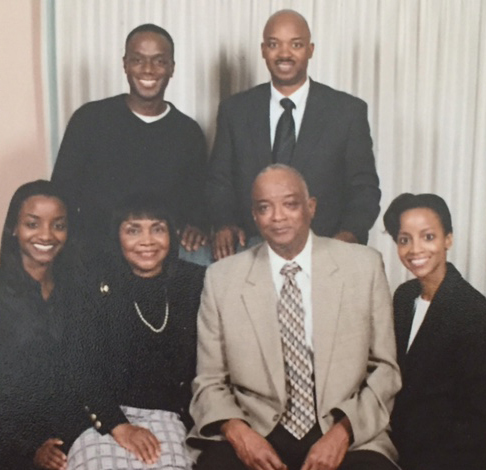
Dr. Harold Jordan and his wife Geraldine C. Jordan surrounded by their children, (clockwise from lower left), Dr. Kristi Jordan Graham, Vince Jordan, Harold Jordan II, and Karen Jordan. (Courtesy Jordan family).
From across the decades of an honored career in medicine, Jordan, who turned 80 this year (2017), says he has no ill feeling about such slights. “I would laugh at them, like, ‘What are you talking about?’” he said.
After his three years of residency at VUMC, Jordan pursued his academic career at Meharry and his public service career with the State of Tennessee, but also maintained a clinical appointment on the faculty of the Vanderbilt University School of Medicine until 2016.
In a 1971 letter in support of Jordan’s faculty appointment at Vanderbilt, Robert M. Reed, MD, a Psychiatry faculty member of that era, wrote that, since Jordan was the first Black resident to train at Vanderbilt, “his original appointment and subsequent performance were watched and monitored by a great many people as constituting something of a ‘test case.’”
He adds, “If indeed it were a test, then Harold passed it with honors, in my opinion.”
Andre Churchwell, MD, Chief Diversity Officer for Vanderbilt University Medical Center, senior associate dean for Diversity Affairs, and Levi Watkins Jr. M.D. Chair, professor of Medicine, Biomedical Engineering and Radiology and Radiological Sciences, said that Jordan’s contributions to VUMC are important to remember.
“He paved the way for everyone who came after him,” Churchwell said. “To be an African-American resident in a sea of white residents at a Southern medical institution, I would call him a true Robinson Crusoe.”
A 1967 Psychiatry departmental group photo makes Churchwell’s point. It shows 40 or so people lined up around the traditional entrance to the School of Medicine, and Jordan is indeed the only African-American in a sea of white faces.
Given the varieties of reactions to Jordan’s presence and his role at the Medical Center in the mid-1960s, Churchwell added, “The fact that he was studying psychiatry probably helped him.”
For his part, Jordan says his time at Vanderbilt was important to him, both personally and professionally.
“It was a very positive influence,” he said. “I just felt very supported at both Meharry and Vanderbilt. I felt blessed to have had that experience in Psychiatry.”






